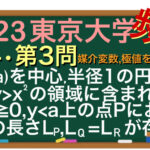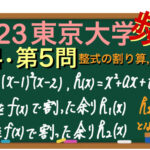【2023東京大学・理科・第4問】
座標空間内の \(4\) 点 \(O(0,0,0)\),\(A(2,0,0)\),\(B(1,1,1)\),\(C(1,2,3)\) を考える.
(1) \(\overrightarrow{OP}\perp\overrightarrow{OA}\),\(\overrightarrow{OP}\perp\overrightarrow{OB}\),\(\overrightarrow{OP}\cdot\overrightarrow{OC}=1\) を満たす点 \(P\) の座標を求めよ.
(2) 点 \(P\) から直線 \(AB\) に垂線を下ろし,その垂線と直線 \(AB\) の交点を \(H\) とする.\(\overrightarrow{OH}\) を \(\overrightarrow{OA}\) と \(\overrightarrow{OB}\) を用いて表せ.
(3) 点 \(Q\) を \(\overrightarrow{OQ}=\displaystyle\frac{3}{4}\overrightarrow{OA}+\overrightarrow{OP}\) により定め,\(Q\) を中心とする半径 \(r\) の球面 \(S\) を考える.\(S\) が三角形 \(OHB\) と共有点を持つような \(r\) の範囲を求めよ.ただし,三角形 \(OHB\) は \(3\) 点 \(O\) , \(H\) , \(B\) を含む平面内にあり,周とその内部からなるものとする.
解答・解説
(1) 点 \(P\) の座標
\(P(a,b,c)\) とおく.
\(\overrightarrow{OP}\perp\overrightarrow{OA}\) \(\iff\) \(\overrightarrow{OP}\cdot\overrightarrow{OA}=0\) \(\iff\) \(2a=0\)
よって \(a=0\) ・・・①
\(\overrightarrow{OP}\perp\overrightarrow{OB}\) \(\iff\) \(\overrightarrow{OP}\cdot\overrightarrow{OB}=0\) \(\iff\) \(a+b+c=0\)
①より \(b+c=0\) ・・・②
\(\overrightarrow{OP}\cdot\overrightarrow{OC}=1\) \(\iff\) \(a+2b+3c=1\)
①より \(2b+3c=1\) ・・・③
②,③より \(b=-1\),\(c=1\)
したがって,\(P(0,-1,1)\)
(2) \(\overrightarrow{OH}\) を \(\overrightarrow{OA}\) と \(\overrightarrow{OB}\) を用いて表せ.
実数 \(k\) を用いて \(\overrightarrow{AH}=k\overrightarrow{AB}\) とおける.
\(\overrightarrow{OH}=\overrightarrow{OA}+k\overrightarrow{AB}=(2,0,0)+k(-1,1,1)\)
よって \(\overrightarrow{OH}=(-k+2,k,k)\) であるから
\(\overrightarrow{PH}=(-k+2,k+1,k-1)\) となり,
\(\overrightarrow{PH}\perp\overrightarrow{AB}\) より \(\overrightarrow{PH}\cdot\overrightarrow{AB}=0\)
\(-(k+2)+(k+1)+(k-1)=0\) \(\iff\) \(k=\displaystyle\frac{2}{3}\)
したがって,\(\overrightarrow{OH}=\overrightarrow{OA}+\displaystyle\frac{2}{3}\overrightarrow{AB}\)
よって,\(\overrightarrow{OH}=\displaystyle\frac{1}{3}\overrightarrow{OA}+\displaystyle\frac{2}{3}\overrightarrow{OB}\)

より発展的な考え方・解法として,「正射影ベクトル」を利用しても解くことができます!余力のある方はぜひチャレンジを!
正射影ベクトルについては「【2009京都大学】正射影ベクトルとは?正射影ベクトルの利用・演習」を参考に!

(3) \(S\) が三角形 \(OHB\) と共有点を持つような \(r\) の範囲
\(\triangle OHB\) の周および内部の点 \(R\) は
\(0≦s≦1\),\(0≦t≦1\),\(0≦s+t≦1\) を満たす実数 \(s\),\(t\) を用いて
\(\overrightarrow{OR}=s\overrightarrow{OH}+t\overrightarrow{OB}\)
\(=s\left(\displaystyle\frac{1}{3}\overrightarrow{OA}+\displaystyle\frac{2}{3}\overrightarrow{OB}\right)+t\overrightarrow{OB}\)
よって \(\overrightarrow{OR}=\displaystyle\frac{s}{3}\overrightarrow{OA}+\left(\displaystyle\frac{2s}{3}+t\right)\overrightarrow{OB}\)
\(\overrightarrow{QR}=\overrightarrow{OR}-\overrightarrow{OQ}=\left(\displaystyle\frac{s}{3}-\displaystyle\frac{3}{4}\right)\overrightarrow{OA}+\left(\displaystyle\frac{2s}{3}+t\right)\overrightarrow{OB}-\overrightarrow{OP}\)
\(\overrightarrow{OP}\cdot\overrightarrow{OA}=\overrightarrow{OP}\cdot\overrightarrow{OB}=0\),\(\overrightarrow{OA}\cdot\overrightarrow{OB}=2\),
\(\left|\overrightarrow{OA}\right|^2=4\),\(\left|\overrightarrow{OB}\right|^2=3\),\(\left|\overrightarrow{OP}\right|^2=2\) より
\(\left|\overrightarrow{QR}\right|^2=\left(\displaystyle\frac{s}{3}-\displaystyle\frac{3}{4}\right)^2\times 4+\left(\displaystyle\frac{2s}{3}+t\right)^2\times 3+2+2\left(\displaystyle\frac{s}{3}-\displaystyle\frac{3}{4}\right)\left(\displaystyle\frac{2s}{3}+t\right)\times 2\)
\(=\displaystyle\frac{8}{3}s^2+\displaystyle\frac{16}{3}st+3t^2-4s-3t+\displaystyle\frac{17}{4}\)
\(=\displaystyle\frac{8}{3}\left(s+t-\displaystyle\frac{3}{4}\right)^2+\displaystyle\frac{1}{3}\left(t+\displaystyle\frac{3}{2}\right)^2+2\)
\(0≦s≦1\),\(0≦t≦1\),\(0≦s+t≦1\) であることに注意して \(\left|\overrightarrow{QR}\right|^2\) 最大値,最小値を考えると
\(\begin{cases}s+t=\displaystyle\frac{3}{4}\\t=0\end{cases}\)
\(\iff\) \(s=\displaystyle\frac{3}{4}\),\(t=0\) のとき最小値:\(\displaystyle\frac{11}{4}\)
\(\begin{cases}s+t=1\\t=1\end{cases}\)
\(\iff\) \(s=0\),\(t=1\) のとき最小値:\(\displaystyle\frac{17}{4}\)
したがって \(\displaystyle\frac{11}{4}≦r^2≦\displaystyle\frac{17}{4}\)
つまり,\(\displaystyle\frac{\sqrt{11}}{2}≦r≦\displaystyle\frac{\sqrt{17}}{2}\)

今回は,\(2\) 変数関数の最大・最小値に帰着させました。
図形的なアプローチでの解法も可能かと思います。
ぜひ様々な解法を考え,思考力UPを!








コメント